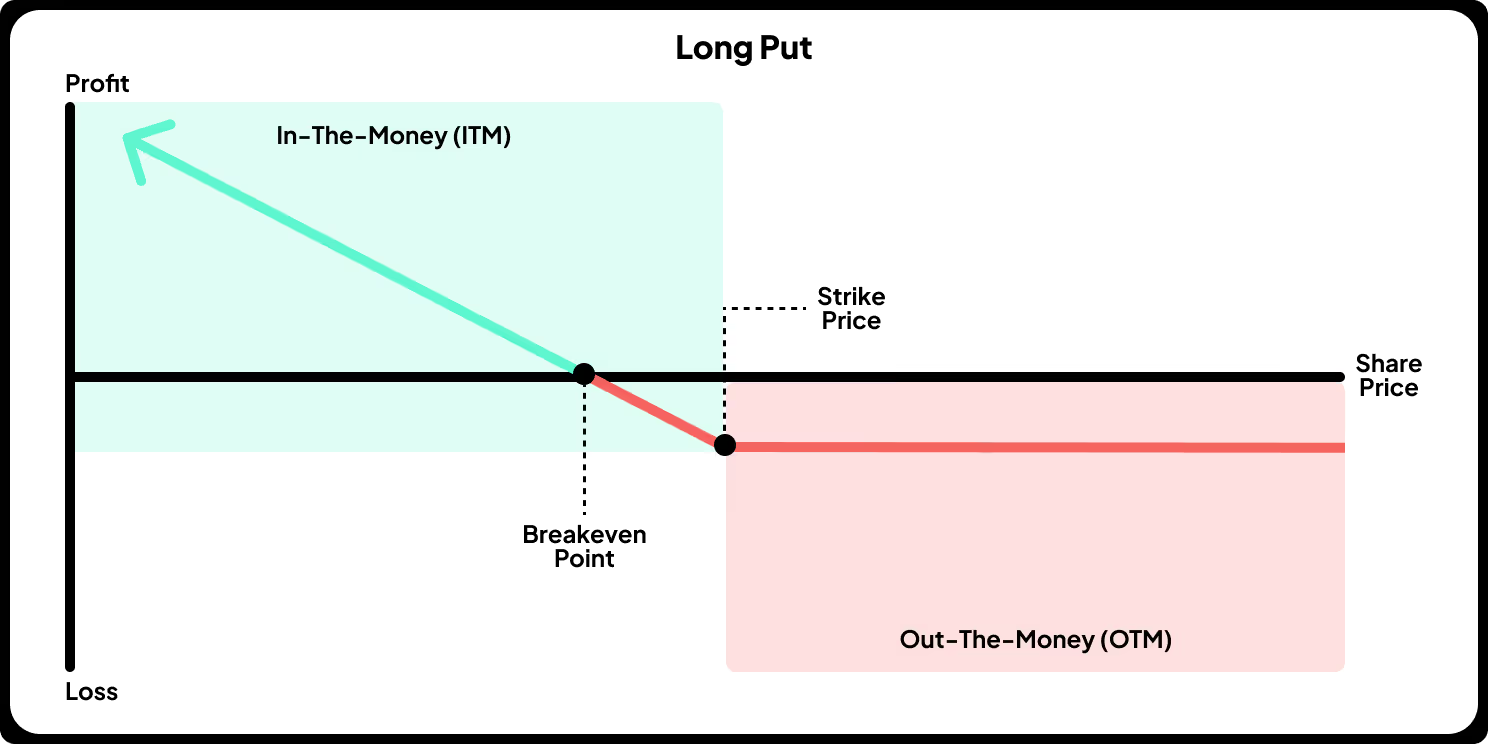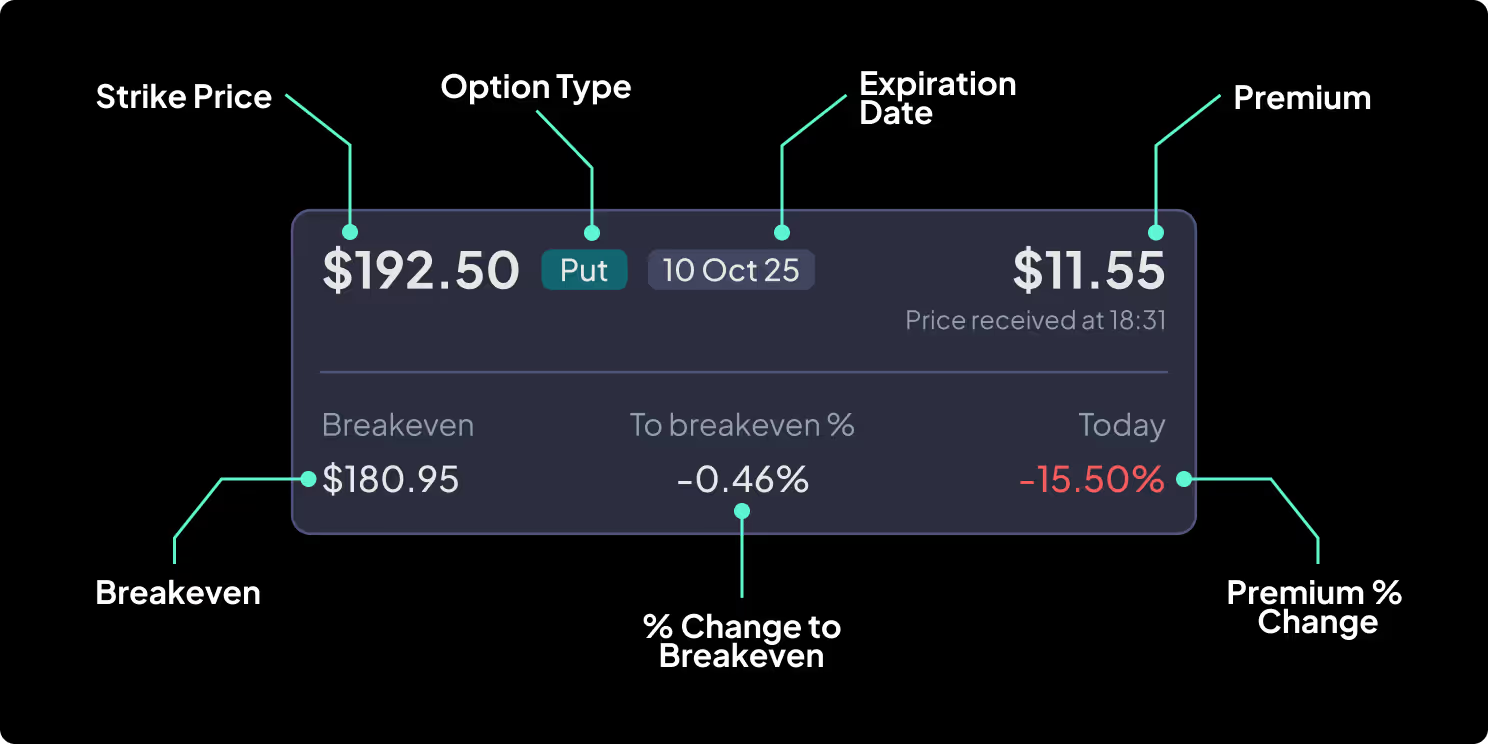What is a Put Option?
A put option is a contract that gives the buyer the right, but not the obligation, to sell a specific asset (usually a stock) at a predetermined price (the strike price) before a set expiration date. It can bethought of as a form of protection that allows you to sell a stock at a fixed price, regardless of how low the market price might fall. If the stock doesn’t decline, the option may expire worthless.
Key Components of a Put Option
- Underlying Asset: The stock or security the option is based on
- Strike Price: The price at which you can sell the underlying asset
- Premium: The cost you pay to buy the option
- Expiration Date: When the option contract expires
- Contract Size: Typically represents 100 shares of the underlying stock
- Intrinsic Value: The Strike Price minus the current price of the Underlying Asset (if the option is in the money)
How Put Options Work: A Real-WorldExample
Let’s walk through a hypothetical scenario to see how a put option might work.
Important:These examples are for illustrative purposes only. Options are complex products and not suitable for all investors. Capital is at risk.
Example 1: Tesla (TSLA)Put Option
Imagine Tesla is currently trading at $250 per share. You believe the price may fall in the next month, perhaps due to market sentiment or a disappointing earnings report.
Instead of short selling the stock, you decide to buy a put option with:
- Strike price: $240
- Expiration: 30 days from now
- Premium: $8 per share
Rationale for this strategy:
- Defined Risk: Your maximum loss is the premium paid ($800), even if Tesla's price rises.
- DownsideProtection or Profit Potential: If Tesla’s price drops, your put option may increase in value.
- Leverage: You can gain exposure to a larger potential price movement without needing to short sell the stock or tie up large amounts of capital.
Why the Put Option Gains Value
All else equal, as Tesla’s stock price moves closer to or below the $240 strike price, the right to sell Tesla at $240 becomes more valuable. For instance, if Tesla falls to $230, having the option to sell it at a higher price of $240 is more attractive and so the option becomes more valuable.
Scenario Analysis
Let's explore different hypothetical outcomes:
Scenario 1:Tesla falls to $200 by expiration
Your put option gives you the right to sell 100 shares at $240 while the market price is only $200.
- Intrinsic value: $40 per share ($240 - $200)
- Profit calculation: ($40 × 100) - $800 = $3,200
- Return on investment: 400% ($3,200 profit on $800 investment)
Scenario 2:Tesla drops slightly to $235
Your put option gives you the right to sell at $240, while the market price is $235.
- Intrinsic value: $5 per share ($240 - $235)
- Profit calculation: ($5 × 100) - $800 = -$300
- Result: You lose money even though the stock fell, because the drop wasn't enough to cover the premium paid.
Scenario 3:Tesla rises to $260
Your put option is "out of the money" because the market price ($260) is above your strike price ($240).
- Intrinsic value :$0
- Result: The option expires worthless, and you lose the $800 premium.
When to Consider Using Put Options
Put options may be used in several scenarios:
- You expect a decline in a stock’s price and want to potentially profit from that movement with defined maximum risk (limited to the premium paid).
- You already own the stock and want to protect against downside risk (a strategy known as a protective put)
- You want to avoid short selling but still want bearish exposure to the stock price

Considerations Before Trading Put Options
- Time Decay: Like call options, puts lose value over time, especially in the final weeks before expiration
- ImpliedVolatility: Higher volatility means higher premiums. But after big events(like earnings), volatility often drops — reducing the option’s value even if the stock moves as expected
Break-Even Point: Strike Price -Premium Paid. In this example: $240 - $8 = $232
(You would need the stock price to fall below this level to begin making a profit at expiration.)
Recap
Put options can provide a structured way to gain exposure to potential falling prices or to protect existing holdings. They offer limited risk, flexibility, and strategic downside exposure -but do also carry the risk of losing the entire amount that you spend on the puts (premium spend).
But remember: options trading isn’t for everyone. It's important to thoroughly understand the mechanics and risks before trading options.



